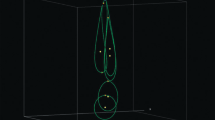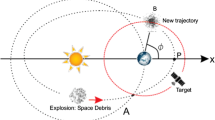Abstract
The goal of the present paper is to study close approaches of a cloud of particles with an oblate planet, which means that there is a \(J_{2}\) term in the gravitational potential of the planet. This cloud of particles is assumed to be created during the passage of a spacecraft by the periapsis of its orbit, by an explosion or any other disruptive event. The system is formed by two large bodies (Sun and planet), assumed to be in circular orbits around the center of mass of the system, and the cloud of particles. The particles that belong to the cloud make a close approach to the flat planet and then they are dispersed by the gravitational force of the planet. The motion is governed by the equations of motion given by the planar restricted circular three-body problem plus the effects of the oblateness of the planet. Jupiter is used for numerical simulations. The results show the differences between the behavior of the cloud after the passage, considering or not the effects of the oblateness of the planet. The results show that the oblateness of the planet is equivalent to an increase in the mass of the planet.





Similar content being viewed by others
References
Broucke RA (1988) The celestial mechanics of gravity assist. AIAA paper 88-4220. In: AIAA/AAS astrodynamics conference, Minneapolis, MN, 15–17 Aug
Brouwer D, Clemence G (1961) Methods of celestial mechanics. Academic Press, Massachusetts
Byrnes DV, D’Amario LA (1982) A combined Halley flyby Galileo mission. AIAA paper, 82-1462
Carvell R (1986) Ulysses—the Sun from above and below. Space 1:18
Casalino L, Colasurdo G, Pastrone D (1999) Optimal low-thrust escape trajectories using gravity assist. J Guidance Control Dyn 22(5):637–642
D’Amario LA, Byrnes DV (1983) Interplanetary trajectory design for the Galileo mission. In: AIAA, aerospace sciences meeting, vol 1
D’Amario LA, Sackett LL, Stanford RH, Byrnes DV (1979) Optimization of multiple flyby trajectories. In: American Institute of Aeronautics and Astronautics conference, vol 1
D’Amario LA, Byrnes DV, Stanford RH (1981) A new method for optimizing multiple-flyby trajectories. J Guidance Control Dyn 4(5):591–596
D’Amario LA, Byrnes DV, Stanford RH (1982) Interplanetary trajectory optimization with application to Galileo. J Guidance Control Dyn 5(5):465–471
Farquhar RW, Dunham DW (1981) A new trajectory concept for exploring the Earth’s geomagnetic tail. J Guidance Control Dyn 4(2):192–196
Gomes VM, Prado AFBA (2008) Swing-by maneuvers for a cloud of particles with planets of the solar system. WSEAS Trans Appl Theor Mech 3(11):869–878
Gomes VM, Prado AFBA (2010) A study of the impact of the initial energy in a close approach of a cloud of particles. WSEAS Trans Math 9(10):811–820
Gomes VM, Prado AFBDA, Golebiewska J (2013) Dynamics of space particles and spacecrafts passing by the atmosphere of the Earth. Sci World J 2013:1–6
Heaton AF, Strange NJ, Longuski JM, Bonfiglio EP (2002) Automated design of the Europa Orbiter tour. J Spacecr Rockets 39(1):17–22
Hollister WM, Prussing JE (1966) Optimum transfer to Mars via Venus (transfer paths to Mars via Venus compared with direct flight, discussing direct free fall transfer, flyby and free fall transfer). Astronaut Acta 12:169–179
Kohlhase CE, Penzo PA (1977) Voyager mission description. Space Sci Rrev 21(2):77–101
Lanoix E (1996) Tether sling shot assists—a novel approach to travelling in the solar system. In: CASI conference on astronautics—towards the next century in space, 9th, Ottawa, Canada, pp 62–71
Lanoix ELM, Misra AK (2000) Near-earth asteroid missions using tether sling shot assist. J Spacecr Rockets 37(4):475–480
Longman RW, Schneider AM (1970) Use of Jupiter’s moons for gravity assist. J Spacecr Rockets 7(5):570–576
Longuski JM, Williams SN (1991) The last grand tour opportunity to Pluto. J Astronaut Sci 39:359–365
Marsh SM, Howell KC (1988) Double lunar swingby trajectory design. AIAA paper, 88-4289
McConaghy TT, Debban TJ, Petropoulos AE, Longuski JM (2003) Design and optimization of low-thrust trajectories with gravity assists. J Spacecr Rockets 40(3):380–387
Penzo PA, Mayer HL (1986) Tethers and asteroids for artificial gravity assist in the solar system. J Spacecr Rockets 23(1):79–82
Prado AFBA, Broucke R (1995a) Classification of swing-by trajectories using the Moon. Appl Mech Rev 48(11S):S138–S142
Prado AFBA, Broucke R (1995b) Effects of atmospheric drag in swing-by trajectory. Acta Astronaut 36(6):285–290
Puig-Suari J, Longuski JM, Tragesser SG (1995) A tether sling for lunar and interplanetary exploration. Acta Astronaut 35:671–680
Sanchez DM, Yokoyama T, Brasil PIDO, Cordeiro RR (2009) Some initial conditions for disposed satellites of the systems GPS and Galileo constellations. Math Probl Eng 2009:510759. doi:10.1155/2009/510759
Strange NJ, Longuski JM (2002) Graphical method for gravity-assist trajectory design. J Spacecr Rockets 39(1):9–16
Striepe SA, Braun RD (1991) Effects of a Venus swingby periapsis burn during an Earth-Mars trajectory. J Astronaut Sci 39(3):299–312
Sukhanov AA (1999) Close approach to Sun using gravity assists of the inner planets. Acta Astronaut 45(4):177–185
Swenson BL (1992) Neptune atmospheric probe mission. AIAA paper (92-4371)
Szebehely VG (1967) Theory of orbits. Academic Press, New York
Thompson WB, Stern MO, Dubin DHE (1998) A skyhook from Phobos to Mars. J Br Interplanet Soc 51(3):99–115
Acknowledgments
The authors wish to express their appreciation for the support provided by Grants # 473387/2012-3, 304700/2009-6 and 473164/2013-2 from the National Council for Scientific and Technological Development (CNPq); Grants # 2011/08171-3, 2011/13101-4, 2014/06688-7, 2012/21023-6 and 2014/22295-5 from São Paulo Research Foundation (FAPESP) and the financial support from the National Council for the Improvement of Higher Education (CAPES).
Author information
Authors and Affiliations
Corresponding author
Additional information
Communicated by Elbert E. N. Macau, Antônio Fernando Bertachini de Almeida Prado and Cristiano Fiorilo de Melo.
Rights and permissions
About this article
Cite this article
Gomes, V.M., Oliveira, G.M.C., Prado, A.F.B.A. et al. Close approach of a cloud of particles around an oblate planet. Comp. Appl. Math. 35, 663–673 (2016). https://doi.org/10.1007/s40314-015-0264-x
Received:
Revised:
Accepted:
Published:
Issue Date:
DOI: https://doi.org/10.1007/s40314-015-0264-x




